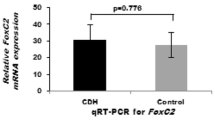Abstract
Background
Congenital diaphragmatic hernia (CDH) is a birth defect associated with abnormal lung development. Yes-associated protein (YAP) is a core kinase of the Hippo pathway, which controls organ size during development. The absence of YAP protein during lung development results in hypoplastic lungs comparable to the lung phenotype in CDH (Mahoney, Dev Cell 30(2):137–150, 2014). We aimed to describe the expression of YAP during normal and nitrofen-induced abnormal lung development.
Methods
Intra-gastric administration of dams with 100 mg of nitrofen was used to induce CDH and abnormal lung development in the embryos. Immunofluorescence was performed to visualize the localization of YAP and p-YAP during lung development (E15, E18, E21). Western Blotting was used to determine the abundance of YAP and p-YAP in E21 control and nitrofen-induced hypoplastic CDH lungs.
Results
Immunofluorescence demonstrated cytoplasmic localization of YAP protein in airway epithelial and mesenchymal cells of nitrofen-induced hypoplastic lungs compared to nuclear localization in control lungs. Western Blotting showed a decrease (p = 0.0188) in abundance of YAP (active form) and increase in p-YAP (inactive form) in hypoplastic lungs compared to control lungs.
Conclusion
Our results demonstrate that YAP protein is mostly phosphorylated, inactive, and expressed in the cytoplasm at the later stages of nitrofen-induced hypoplastic lung development indicating that the alteration in regulation of YAP can be associated with the pathogenesis of abnormal lung development in experimental CDH.




Similar content being viewed by others
References
McGivern MR, Best KE, Rankin J, Wellesley D, Greenlees R, Addor MC et al (2015) Epidemiology of congenital diaphragmatic hernia in Europe: A register-based study. Arch Dis Child Fetal Neonatal Ed 100(2):F137–F144
Keijzer R, Liu J, Deimling J, Tibboel D, Post M (2000) Dual-hit hypothesis explains pulmonary hypoplasia in the nitrofen model of congenital diaphragmatic hernia. Am J Pathol 156(4):1299–1306
Khoshgoo N, Kholdebarin R, Pereira-terra P, Mahood TH, Falk L, Day CA, et al (2017) Prenatal microRNA miR-200b therapy improves nitrofen- induced pulmonary hypoplasia associated with congenital diaphragmatic hernia. Ann Surg. 1–9
Herrera-Rivero M, Zhang R, Heilmann-Heimbach S, Mueller A, Bagci S, Dresbach T et al (2018) Circulating microRNAs are associated with pulmonary hypertension and development of chronic lung disease in congenital diaphragmatic hernia. Sci Rep 8(1):1–11
Fu V, Plouffe SW, Guan KL (2017) The Hippo pathway in organ development, homeostasis, and regeneration. Curr Opin Cell Biol 49:99–107
Mahoney JE, Mori M, Szymaniak AD, Varelas X, Cardoso WV (2014) The hippo pathway effector yap controls patterning and differentiation of airway epithelial pogenitors Sox9 Y. Dev Cell 30(2):137–150
Maître JL (2017) Mechanics of blastocyst morphogenesis. Biol Cell 109(9):323–338
Yeung B, Yu J, Yang X (2016) Roles of the Hippo pathway in lung development and tumorigenesis. Int J Cancer 138(3):533–539
Aihole J, Gowdra A, Javaregowda D, Jadhav V, Babu M, Sahadev R (2018) A clinical study on congenital diaphragmatic hernia in neonates: our institutional experience. J Indian Assoc Pediatr Surg 23:131–139
Przemysław Kosiński MW (2017) Congenital diaphragmatic hernia: Pathogenesis, prenatal diagnosis and management. Via Medica 88(1):24–30
Wynn J, Yu L, Chung WK (2014) Genetic causes of congenital diaphragmatic hernia. Semin Fetal Neonatal Med 19(6):324–330
Dalmer TRA, Clugston RD (2018) Gene ontology enrichment analysis of congenital diaphragmatic hernia-associated genes. Pediatr Res 85:13–19
Tomlinson V, Gudmundsdottir K, Luong P, Leung KY, Knebel A, Basu S (2010) JNK phosphorylates Yes-associated protein (YAP) to regulate apoptosis. Cell Death Dis. https://doi.org/10.1038/cddis.2010.7
Plouffe SW, Hong AW, Guan KL (2015) Disease implications of the Hippo/YAP pathway. Trends Mol Med 21(4):212–222. https://doi.org/10.1016/j.molmed.2015.01.003
Acknowledgements
This research was supported by funds to RK from the Children’s Hospital Research Institute of Manitoba. RK is the inaugural Thorlakson Chair in Surgical Research for the Department of Surgery at the University of Manitoba.
Author information
Authors and Affiliations
Corresponding author
Ethics declarations
Conflict of interest
The authors declare no conflict of interest.
Additional information
Publisher's Note
Springer Nature remains neutral with regard to jurisdictional claims in published maps and institutional affiliations.
Rights and permissions
About this article
Cite this article
Kahnamoui, S., Khoshgoo, N., Patel, D. et al. Yes-associated protein is dysregulated during nitrofen-induced hypoplastic lung development due to congenital diaphragmatic hernia. Pediatr Surg Int 38, 713–719 (2022). https://doi.org/10.1007/s00383-022-05099-x
Accepted:
Published:
Issue Date:
DOI: https://doi.org/10.1007/s00383-022-05099-x




